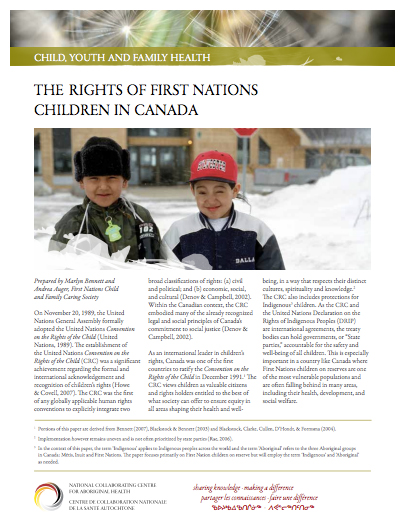Data resource for grant writing: National Collaborating Centre for Aboriginal Health factsheet
 The Rights of First Nations Children in Canada factsheet produced by the National Collaborating Centre for Aboriginal Health highlights that First Nations children continue to experience unacceptable and disproportional levels of risk due to a combination of historical trauma, intergenerational poverty, and discriminatory and underfunded child welfare policies.
The Rights of First Nations Children in Canada factsheet produced by the National Collaborating Centre for Aboriginal Health highlights that First Nations children continue to experience unacceptable and disproportional levels of risk due to a combination of historical trauma, intergenerational poverty, and discriminatory and underfunded child welfare policies.
[hr]
The factsheet outlines the following major issues:
- Aboriginal children in Canada experience disproportionate levels of poverty
- Child welfare policies and funding continue to undermine the health of First Nations Children
- First Nations parents are in the best position to care for their children and should have supports to assist them when needed
The factsheet explores international concerns that have been raised for Aboriginal Children in Canada. The United Nations Committee on the Rights of the Child (UNCRC), in its annual review, “continues to express deep concern about the lack of progress in implementing the rights of Indigenous children” and in a report strongly criticized Canada for lack of progress in discrimination against Aboriginal children and youth in the following areas:
- The significant over-representation of Aboriginal children in the child welfare system
- The ongoing inequitable funding for child welfare services for First Nations children on reserves
- Inadequate cultural supports while Aboriginal children are in out-of-home care, leading to concerns about loss of identity and culture
- Removals of children from their families as a first resort in cases of neglect, financial hardship or disability
- Inappropriate child welfare care placements
- Poor child welfare care outcomes
- Abuse and neglect whilst in child welfare care
- Inadequate preparation for life after child welfare care
- Child welfare caregivers with little training or preparation
- Child welfare care placements for Aboriginal children in homes outside their communities
- Health concerns for Aboriginal children and youth including:
- Violence against Aboriginal women and girls
- Mental health of Aboriginal children
- The continued high suicide rate amongst Aboriginal youth
- The Government of Canada’s lack of a national poverty initiative
- Regional inequities and inadequacies of welfare services in meeting needs of Aboriginal children
- Educations concerns for Aboriginal children and youth including:
- The high dropout rate amongst Aboriginal youth
- Inappropriate and excessive use of disciplinary measures applied in schools
The Committee also drew attention to the fact that Aboriginal youth are more likely to be involved in the criminal justice system than to graduate from high school, and noted that Canada cannot excuse rights violations due to the federalist structure of the country.
The factsheet concludes “First Nations Children in Canada continue to suffer disproportionately from high rates of child poverty, from high levels of neglect, and from a child welfare system that fails to adequately protect them through culturally-appropriate services (Blackstock, 2007). First Nations children and all children should have access to community-based and culturally appropriate services which will help them grow up safe, healthy, and spiritually strong and be free from abuse, neglect, sexual exploitation, and the damaging effects of neglect and caregiver substance abuse…. In order for this to occur, it is important that First Nations families (and their respective organizations) be given the resources they need to ensure that the rights of Aboriginal children under their care are upheld and respected…. In order to help vulnerable children such as First Nations children, a community developed, outcomes-directed, child-centred national plan in Canada is required.”
The CRC provides a global standard or framework for all governments, calling for “continuous action and progress in the realization of children’s rights”, underpinned by four general principles:
- Non-discrimination (Article 2)
- The best interests of the child (Article 3)
- The child’s right to survival and development (Article 6)
- Respect for the children’s views and for their right to participate in all aspects of democratic society (Articles 12 to 15)
In their report Keeping the Promise, the First Nations Child and Family Caring Society of Canada identified possible CRC-defined rights violations in Canada based on the following 3 situations:
- Where First Nations children and young people face disproportionate risk relating to one or more articles of the CRC
- Where there is an identified risk to First Nations children and young people relating to one or more articles of the CRC – particularly when the risk is severe and persistent
- Where there is little evidence that the State government has considered how to ensure the right is realized for First Nations children and young people (Blackstock et al., 2004, p. 16)